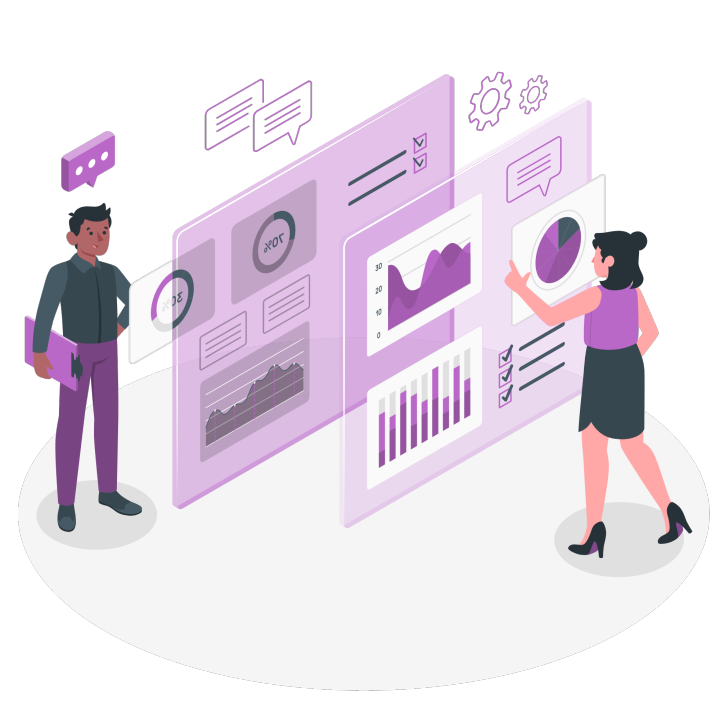Thinking with AI – When asked to identify a corporation that employs AI, people often mention technical powerhouses. However, executives in legacy organisations in other sectors may believe that transforming with AI is beyond their capabilities. Because AI is still relatively new, all successful firms have to complete the same tasks: placing people in charge of developing AI, gathering data, talent, and capital, and aggressively increasing capabilities.

Many organisations’ AI projects are too tiny and insufficient to generate economic benefit. According to a 2019 poll, seven out of ten organisations reported limited or no benefit from their AI initiatives. However, research has identified 30 organisations and government bodies who have effectively implemented AI by investing heavily and enjoying the rewards. These organisations followed ten steps to become effective AI adopters.
To benefit from AI, organisations must reconsider how people and robots interact. Concentrate on apps that influence staff performance and consumer interactions. Consider using AI in critical functions to enable new processes and data-driven decision-making. AI should generate new solutions and business models, ultimately altering all aspects of the industry.
To properly accomplish AI transformation, firms must avoid fragmented attempts and focus on all ten objectives outlined in this article. Examples show how certain organisations prospered. Your firm may tackle the duties differently or in a different sequence.
What you hope to achieve by using AI.
Here is a shortened, revised version of the text you provided:
Ambitious firms have a clear vision of how they want to use AI. Identifying and creating transformative AI involves a specific goal, such as increasing process speed, lowering costs, or becoming better marketers. We advocate focusing on one well-defined, overarching goal to lead AI adoption.
When Deloitte’s audit and assurance group created Omnia, a proprietary AI platform, the overarching goal was to enhance service quality internationally. Developing a worldwide solution necessitated addressing variances in data law, privacy, audit procedures, and risk management. Because of the disparities in data architectures, extracting pertinent data and placing it into an auditing platform may be time-consuming. Creating a single data model that would function across clients and locations posed distinct problems.
By envisioning Omnia as a worldwide tool before it was established, Deloitte’s engineers were able to concentrate on standardising information from various firms in different nations. This was a massive task that would have been significantly more difficult later in the development process.
Collaborative partnerships for improved results
Deloitte had to watch technological start-ups to locate solutions that met their requirements while developing Omnia. Strong alliances are essential for AI success. Deloitte collaborated with Kira Systems to extract contract terms from legal documents using natural language processing technology. Another partner, Signal AI, developed a platform for analysing financial data and identifying risk concerns. Trustworthy AI, created in collaboration with Chatterbox Labs, is a new addition to Omnia that assesses bias in AI models.
Analytics initiatives thinking with AI
Prior to using AI, the majority of successful adopters conducted large analytics programmes. Mastering analytics is critical for AI adoption, as is a commitment to leveraging data and analytics for the majority of decisions. This includes transforming consumer interactions, incorporating AI into goods and services, and automating operations and procedures. Companies that want to revolutionise their businesses with AI need unique or exclusive data to distinguish their machine-learning models and results.

Revolutionise human-machine interaction to realise AI’s full potential.
Seagate Technology has used sensor data to enhance production processes, such as automating the visual examination of silicon wafers. An automated approach enables robots to detect and categorise wafer flaws, saving millions in inspection labour expenses and scrap avoidance. Visual inspection accuracy has now surpassed 90%. Data is the cornerstone of machine learning success, and obtaining, cleaning, and integrating the proper data is the most significant challenge for scaling up AI systems. It is also critical to seek out new data sources for future AI endeavours.
Create an agile and adaptable IT infrastructure.
Deploying data, analytics, and automation across corporate applications need a technical infrastructure that can interface with other IT systems. Integrating software from outside a typical data centre may be time-consuming and costly. A flexible IT infrastructure facilitates the automation of complicated procedures. If you are unable to design such an architecture, you may need to collaborate with a business such as Microsoft Azure, AWS, or Google Cloud. Capital One modernised its culture, operational procedures, and technological infrastructure by adopting an agile methodology, establishing an engineering organisation, recruiting for digital positions, and migrating data to the cloud. thinking with AI
Capital One developed its cloud architecture in collaboration with AWS. Before the shift, executives had to rethink the future of banking. Digital channels generated more data than in-person conversations, allowing the bank to better analyse consumer interactions. Moving to the cloud made strategic sense since it would reduce data storage costs, which had fallen from $2 million per gigabit in 1960 to as low as 2 cents by 2017.
Incorporate AI into Current Work Processes.
Inflexible business procedures may be as restrictive as rigid IT infrastructures. Successful businesses use AI into the everyday processes of their staff and consumers. Determine which processes may benefit from AI speed and intelligence, and then start incorporating AI into them. Avoid cramming technology into processes that won’t benefit from machine speed and scalability. Workflow integration requires a unique strategy as well as hands-on process understanding. Line personnel are well positioned to determine which procedures might benefit from AI and how they can be enhanced.
Some sectors of the United States government have identified particular jobs and processes that are best suited to AI speed and scalability. NASA implemented test initiatives for accounts payable and receivable, IT costs, and human resources. The Social Security Administration uses artificial intelligence to manage huge caseloads and maintain decision-making accuracy. During the Covid-19 outbreak, the Department of Veterans Affairs deployed artificial intelligence chatbots. The Transportation Security Lab is investigating methods to include AI into TSA screening. The IRS is using AI to determine which notifications are most likely to result in payment with thinking with AI
Create holistic solutions throughout the company.
Once you’ve internally tested and perfected AI in a certain process, strive to aggressively spread it across the organisation using a uniform, repeatable methodology. The Cleveland Clinic has “AI popping up all over the place,” which is aided by worker-led initiatives to develop and deploy AI under executive leadership. A cross-organizational community of practice led the endeavour, with corporate analytics, IT, and ethical departments at its core.
Cleveland Clinic, like other organisations embarking on ambitious AI reforms, is grappling with data and analytics difficulties. Hospitals have less data, which is less likely to be clean and organised. Cleveland’s data has quality difficulties, as it is taken and recorded in many formats. Donovan’s department incorporates data preparation into every AI project and gives valuable data sets to all AI initiatives. The clinic employs artificial intelligence to measure risk in population health, using prediction models to prioritise treatment and proactively plan preventative care. They also seek to identify patients who have poor living or working situations that impair their health with thinking with AI
Establish Effective AI Governance and Leadership.
Putting someone in charge of AI deployment facilitates change. The top CEOs understand AI’s capabilities and ramifications for their organisations. The most difficult obstacle is to create a culture that values data-driven decision-making and inspires people to believe in AI’s capabilities. Without this culture, AI activists will lack the necessary resources and support. Leaders should be knowledgeable with information technology, work on various fronts, and invest in the exploration, development, and deployment of artificial intelligence. Commitment to AI must extend across the organisation, with top, middle, and front-line management all on board.
Establish centres of excellence for AI development.
AI and analytics leaders often advocate the technology’s benefits to other management. Decision-makers should provide funds and time for AI initiatives while also incorporating AI into their job. It is critical to educate people on the purpose, appropriateness, and commitment of artificial intelligence. While not every employee need AI training, some do, and more is preferable. Successful businesses need skills and expertise in AI, data engineering, and data science with thinking with AI
When Piyush Gupta became CEO of DBS Bank in 2009, the company had low customer service scores. Gupta committed $300 million every year in AI testing and enabled business divisions to recruit data scientists. The HR director formed a committee to test AI apps, including JIM, which forecasts staff turnover and assists in recruiting competent candidates. DBS currently employs twice as many engineers as bankers, focusing on upcoming technology and AI initiatives. The bank’s culture improved, resulting in recognition as the world’s finest bank and outstanding credit ratings. Gupta was ranked as the 89th best-performing CEO in the world in 2019.
Ensure continuous investment in AI
thinking with AI – Aggressively embracing AI is a significant choice that may cost huge corporations billions of dollars. Successful AI adopters consider it the cost of committing to ambitious enterprise-level adoption. After witnessing early results, businesses find it simpler to invest in AI-related data, tools, and people. CCC Intelligent Solutions, for example, spends more than $100 million a year on AI and data. Certified Collateral Corporation, founded in 1980, offered automobile appraisal information to insurers. CCC developed to gather and manage data, build connections in the car insurance sector, and make judgements based on data, analytics, and artificial intelligence. CCC, which has been led by Githesh Ramamurthy for 23 years, now generates almost $700 million in yearly sales.

CCC’s machine-learning models make use of previous claims, photographs, and data on automotive components, repair shops, crash injuries, and laws. It also includes telematics and sensor data from more than 50 billion miles. CCC offers data and choices to a network of insurance, repair facilities, component suppliers, and automakers. Its purpose is to unite these organisations so that claims may be processed rapidly. Transactions occur on the cloud, where CCC’s systems have been housed since 2003. They link 30,000 businesses and 500,000 consumers, processing $100 billion in transactions yearly. Getting to this stage has been costly and time-consuming.
Continuously explore diverse data sources.
Large corporations normally have little trouble obtaining data, but AI methods rely on the information available. More precise, organised data that can be instantly applied to AI models is desirable. Deloitte had challenges in integrating client data. Capital One possessed valuable data, but it required a flexible IT infrastructure to store and manage it. CCC had amassed data from its initial business model and was preparing for a transition to AI. Its move to an AI-focused firm was reinforced when it discovered how to handle a big volume of fresh data.

Data is more than just words and numbers. CCC considers vehicle photos to be data that may be used to key processes. CCC has gathered billions of photos captured by adjusters or repair companies using professional cameras. In 2012, CCC officials recognised that amateur cameras on cellphones were fast improving. They imagined owners taking their own images for insurance quotations, making the process faster and more cost-effective. CCC invited scholars to investigate the capabilities and learn about deep-learning neural networks for image processing. CCC’s data scientists learnt how to map and identify images for training. By mid-2021, the system was operational, and USAA became a client. The virtuous loop of more data, better models, more business, and more data makes CCC’s use of smartphone images effective.
thinking with AI Companies who embrace AI aggressively, integrate it well into their strategy and processes, and apply it effectively will generate the highest commercial benefit. Knowing what early adopters do might assist others evaluate technology’s potential to impact their company. Organisations might take ten steps to advance in the same direction. AI, when used intelligently and in big amounts, will be vital to future economic success. Data is continuously rising, and AI is a tool for making sense of it at scale and making sound judgements. AI is here to stay, and organisations who actively use it will dominate their industries.

